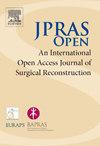Anatomical analysis of the periosteal blood supply system of the fibula using fresh cadavers
IF 1.5
Q3 SURGERY
引用次数: 0
Abstract
A vascularized free fibula flap is often used to reconstruct bone defects. However, bone resorption within the osteotomized segment is often observed. This may be attributed to damage to bone blood flow supplied by nonpenetrating periosteal vessels (NPPVs); however, there are few studies on NPPVs in the fibula. In this study, we investigated dissection methods to assess the vascular network in the fibula and performed a detailed anatomical investigation of NPPVs using fresh cadavers provided by the Clinical Anatomy Laboratory at the Keio University. Three dissection methods were compared to assess the vascular network, and data on the branching, distribution, and number of NPPVs from the peroneal artery were collected. A method involving the elevation of the periosteal bone flap was found to be the most acceptable for assessing fibular NPPVs with less vascular damage. A total of 13 limbs from 7 male and 2 female cadavers were dissected. The number of detected NPPVs was 12-23 per limb (median: 17). No nutrient vessels were detected 5 cm from the proximal and distal ends of the fibula. Fibular NPPVs were distributed in the anterior and posterior directions along the peroneal artery trunk, with more NPPVs toward the posterior. Among the osteotomized segments of 1.0 cm, 30% did not contain any NPPVs, whereas segmentations of 1.5, 2.0, and 3.0 cm resulted in 87%, 95%, and 99% of the segments with at least one NPPV, respectively. These findings for the vascular network in the fibula may help to improve the graft blood supply and prognosis.
新鲜尸体对腓骨骨膜供血系统的解剖分析。
带血管的游离腓骨瓣常用于骨缺损的重建。然而,在截骨节段内经常观察到骨吸收。这可能是由于非穿透性骨膜血管(NPPVs)供应的骨血流受损;然而,关于腓骨nppv的研究很少。在这项研究中,我们研究了解剖方法来评估腓骨血管网络,并使用庆应义塾大学临床解剖实验室提供的新鲜尸体对nppv进行了详细的解剖研究。比较三种解剖方法评估血管网络,收集腓动脉nppv的分支、分布和数量数据。一种涉及骨膜瓣抬高的方法被发现是最可接受的评估腓骨NPPVs的方法,血管损伤较小。共解剖了7具男尸和2具女尸的13条肢体。每条肢体检测到的nppv数量为12-23个(中位数:17个)。距腓骨近端和远端5 cm处未见营养血管。腓骨nppv沿腓骨动脉干前后方向分布,后侧nppv较多。在1.0 cm的截骨节段中,30%的截骨节段不存在任何NPPV,而1.5、2.0和3.0 cm的截骨节段分别有87%、95%和99%的截骨节段存在至少一个NPPV。这些发现可能有助于改善移植物的血供和预后。
本文章由计算机程序翻译,如有差异,请以英文原文为准。
求助全文
约1分钟内获得全文
求助全文
来源期刊

JPRAS Open
Medicine-Surgery
CiteScore
1.60
自引率
0.00%
发文量
89
审稿时长
22 weeks
期刊介绍:
JPRAS Open is an international, open access journal dedicated to publishing case reports, short communications, and full-length articles. JPRAS Open will provide the most current source of information and references in plastic, reconstructive & aesthetic surgery. The Journal is based on the continued need to improve surgical care by providing highlights in general reconstructive surgery; cleft lip, palate and craniofacial surgery; head and neck surgery; skin cancer; breast surgery; hand surgery; lower limb trauma; burns; and aesthetic surgery. The Journal will provide authors with fast publication times.
 求助内容:
求助内容: 应助结果提醒方式:
应助结果提醒方式:


